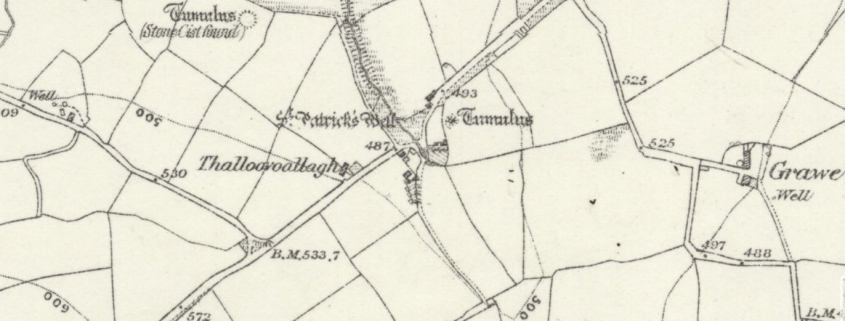Spooyt Phaddy (124) – Lonan
Information
Spooyt Phaddy (or Fhaddy), Lonan. Paddy’s Spout.
Dated April, 1925, the following, by Rev Canon Quine, is an extract from a report on an archaeological excavation at a tumulus near Chibbyr Pherrick, Lonan:
Chibbyr Pherrick means the Well of Patrick. In past generations it was much frequented for cures. It is a perennial spring from under a brow of rock, filling a rocky basin about a foot deep, and overflowing into a little ghyll going down Lllergy Grawe to the Glenroy river. On the other side of the ghyll, thirty yards from the tumulus, is ‘Spoot Phaddy,’ a smaller perennial spring falling over a stone spout. ‘ Pherrick ‘ or ‘ Perrick ‘ is, of course, from Patrick; and Paddy or Phaddy from Palladius, the other apostle of Ireland, who left Ireland and passed over into Scotland, ending his ministry before Patrick began his more successful enterprise.
These questions have a certain interest connected with the site, for the cronk or tumulus stands within ioo yards of the well across the little ghyll. Also, there is a massive menhir about 50 yards from the well on the same side of the ghyll, and over against the tumulus and ‘Spoot Phaddy.’
(text source: Proceedings of the Isle of Man Natural History & Antiquarian Society, Vol.2, No.4, 1926)
![]()
Per W Walter Gill, A Manx Scrapbook, 1929:
Spooyt Fhaddy, Lhergy Grawe, Lonan , about 50 yards below Chibber Pherick. “Paddy’s Spout.” A tumulus and a standing stone near these two wells were removed about 75 years ago.
![]()
Palladius (fl. A.D. 408–431; died c. A.D. 457/461) was the first bishop of Christian Ireland preceding Patrick. The Palladii were thought to be amongst the most noble families of Gaul, and several of them held high ranks in the Church of Gaul. Palladius was married and had a young daughter. He is described as a friend and younger kinsman by Namatianus. In Rome, he kissed his family goodbye in the manner of the Apostles, and lived as an ascetic in Sicily around 408/409, giving his daughter to a convent on that island. He seems to have been ordained as a priest around 415. He lived in Rome between 418–429, and appears to be the “Deacon Palladius”, responsible for urging Pope Celestine I to send the bishop Germanus¹ to Britain, where he guided “the Britons back to the Catholic faith.”
In 431, “Palladius, having been ordained by Pope Celestine, is sent as first bishop to the Scotti”. According to St Prosper, Palladius arrived among the Scots in North Britain after he left Ireland in 431. Scottish church tradition holds that he presided over a Christian community there for about 20 years. His date of death is unknown.
¹ Germanus is traditionally credited with the establishment of the Diocese of Sodor & Man.
(text source: wiki)
![]()
Comment by IOM Wells: It is interesting to speculate that Spooyt Phaddy may be a very old well given Palladius’ dates of flourishment. The area itself is intriguing with the well to Patrick not far away and then there is the raising of a menhir and tumulus close by. The site seems to have had some significance to people in the long ago.
However, Canon Quine writes the tumuls and menhir/stone are still there in 1925 so has Gill, in 1929, made a mistake or is he referring to another tumuls and stone?
Location
The general area of the Spooyt Phaddy is provided above but the exact location is unknown.
Access
Spooytr Phaddy is on private land. Please obtain landowner’s permission.
Links
NLS OS 6″ Sheet XI Surveyed: 1867 Published: 1870
Contact
If you have any information on this well please contact me and quote well record number (124) as this will help identify which well you are referring too.


 Isle of Man Wells welcomes the opportunity to visit as many wells and springs as possible, particularly on private land and with the owner’s permission. If you would like to issue an invitation for us to visit a well or spring on your property please
Isle of Man Wells welcomes the opportunity to visit as many wells and springs as possible, particularly on private land and with the owner’s permission. If you would like to issue an invitation for us to visit a well or spring on your property please